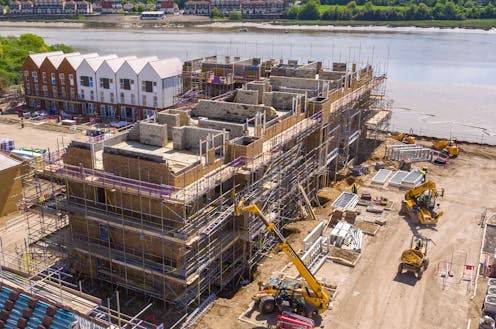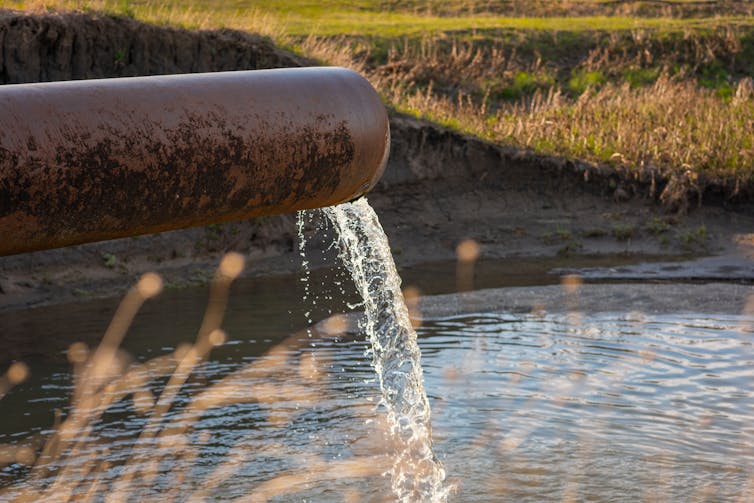
The UK government has announced plans to enable the delivery of 100,000 new homes by 2030 that are currently being held up by a controversial EU law designed to protect water bodies from pollution.
This move will undoubtedly benefit the housing sector, delivering an estimated £18 billion to the economy and also helping the government meet its housing targets. But will it lead to further water pollution at a time when just 36% of the UK’s surface water bodies are in “good” or better condition?
Since 2019, all new housing developments in the UK have been required by EU law to demonstrate that they would not add additional nutrients like nitrogen and phosphorus to water bodies as part of their planning applications.
Wastewater from new homes, as well as run-off from construction sites, can cause nutrients to seep into nearby waterways. This can lead to eutrophication – a process where excessive algae growth degrades water quality.
Developers must calculate how much nutrient pollution the planned accommodation would create and demonstrate how that pollution would be treated or offset. If developers cannot prove that new housing projects are going to be nutrient neutral, planning application is refused.

The main response has been “farmland offsetting” – a scheme where developers pay farmers for parts of their land, which are then rewilded to prevent future farming. The savings made by preventing future nutrient pollution on that farmland would offset the nutrients leaching into the environment from the new housing projects.
Natural England’s nutrient neutrality programme has expanded access to these offsetting schemes in recent years. Nonetheless, not all developers have access to offsetting schemes in their area. Thousands of applications – including many already in the system – have been suspended or rejected as a result.
To re-start many of those stalled applications, the government is proposing an amendment to the law, removing the requirement for developers to prove nutrient neutrality.
The government will instead take responsibility for nutrient offsetting itself – mainly by doubling funding for Natural England’s offsetting scheme. This would enable houses currently stuck in the planning system to be granted permission and begin building.
The government announced that it will also take additional measures to “tackle nutrient pollution at source” by upgrading wastewater treatment works and reducing nutrient pollution from farming.
The implementation of the nutrient neutrality guidelines, and the accompanying burden on developers, has attracted plenty of criticism. Hence, the change in approach in itself is not necessarily a bad thing. However, there is justified concern that the new plans may be less effective if not implemented properly.
Taking control
At a glance, the government’s proposal certainly seems a short-term reaction to a political issue. The government is falling well behind its own housing targets and removing nutrient neutrality from planning applications will release the current deadlock.
But it could also have the potential to do genuine good. By offsetting nutrient pollution itself, the government could deliver more sensible schemes overall than the piecemeal approach delivered by thousands of small planning applications submitted at different times.

However, the long-term success of the offsetting schemes in genuinely achieving nutrient neutrality has been questioned. The calculations are based on a small scientific base. And even if these calculations are correct, offsetting schemes replace pollution that is spread across farmlands with pollution concentrated at the end of a wastewater pipe.
Questioning the new approach
Any potential benefits of the new approach will also rely on it being delivered properly. There are already concerns that may not happen.
A lot of the new environmental measures mentioned in the government’s initial press release are already taking place. For instance, upgrading wastewater treatment works for nutrient removal was made a legal duty in 2022 and is already being planned and implemented by all water companies.
Another – looking at more sustainable drainage solutions – is part of existing planning policy.
Three of the eight actions identified by the government also target farming practices. Agriculture does cause more nutrient pollution than housing – in the Solent region of southern England the Environment Agency estimates that 50% of nutrient pollution can be attributed to agriculture and just 10% to wastewater releases.
However, the purpose of nutrient neutrality was to ensure housing developments dealt with their own pollution so they weren’t adding to the problems already caused by agriculture. Nutrient pollution caused by farming practices is already being addressed through initiatives such as catchment-sensitive farming – a scheme of training and funding to help farmers reduce nutrient pollution.

By taking nutrient neutrality off the “front lines” of the planning process, the concern is that the outcome – away from the same level of scrutiny and urgency – may not be as effective.
Building new homes is important. And it’s also true that new housing developments are not the largest contributor of nutrient pollution in the UK. So a more centralised plan to deal with nutrient pollution has potential benefits, if undertaken seriously.
However, the short-term benefits of building more homes must not overshadow the longer-term commitments the government will need to make in order to properly address the issue of nutrient pollution.

Don’t have time to read about climate change as much as you’d like?
Get a weekly roundup in your inbox instead. Every Wednesday, The Conversation’s environment editor writes Imagine, a short email that goes a little deeper into just one climate issue. Join the 20,000+ readers who’ve subscribed so far.
Peter Cruddas currently receives funding from Ofwat through their Innovation Fund for 'Alternative approaches to phosphorus removal on rural wastewater treatment works'. He has previously received funding from ESRC, EPSRC and the EU FP7 scheme for research into sustainable sanitation.
This article was originally published on The Conversation. Read the original article.







